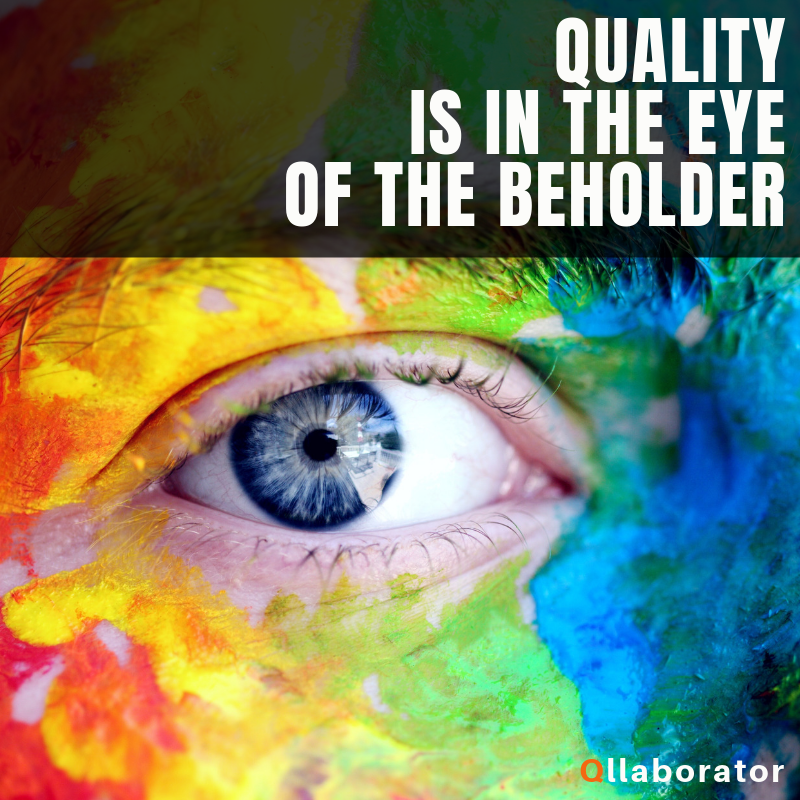Quality is unique, in a sense that we all pursue it, but each of us defines it differently. Quality is about meeting or exceeding customer expectations: every day, every shipment, year after year. But every customer has different needs and different expectations, depending on the target market, product type and complexity. Hence, quality is in part in the eye of the beholders. Looking closely at your organization, chances are CEO, Quality Manager, and other key functions carry a somewhat different opinion on what quality is. The trouble with such an ambiguous definition is misalignment on the role and responsibilities of a quality team. Such misalignment could result in the wrong quality message and affect organization culture. From here, the road for a deterioration in the quality perception of a brand is short.
Let’s look at Quality from the perspective of different stockholders. An engineer, for example, could consider quality as product reliability and performance. Manufacturing team looks at error-free or right-the-first-time (RFT) production, which can be interpreted into cycle time and yield. The quality team obviously will measure no. of complaints and returns, and time to respond. Customer, on the other hand, refers to product serviceability, cost of maintainability and ease of use. Quality looks very contextual and subjective, and it changes over time. Customers are turning their expectations as product ages, or as a reference to competitor’s product. A good example will be a customer that is extremely happy with a product in the first year of use. But higher maintenance costs in the following year can drive satisfaction down. Sometimes, a customer can be perfectly happy with a product, until he gets introduced to another product with additional forms of value. Furthermore, a successful iteration with your customer will immediately set a new baseline of expectations you should adopt.
Obviously, the quality of products or services plays a critical role in every company success. Therefore, the pressure on Quality leaders is HUGE. The challenge is to make the right judgment and layout the correct quality strategy, to align with the customer’s evolving requirements. No magic here – but a methodic repetitive work to understand what it the value we can give, and how can we enable customer success – over time. Be prepared to establish a plan to address these unique requirements of your INTERNAL and end-customers.
The theory sounds simple and logic, the question is how to utilize it in daily life? A six sigma technique known as “Critical to Quality (CTQ) Tree” is a good start. It will support you to identify the needs of your customers – in their language, and then break them into measurable indicators. Analysis of such indicators will allow a better understanding of what’s going well and what’s not. An additional advantage will be a peek into customer tolerance limits for quality. Once you see the whole picture, it will become easier to focus the entire organization around these specific items that will gain the highest value to the customer – to guarantee customer satisfaction at all times.
‘Critical to Quality’ tree can be easily created in three steps:
List critical needs – Once you understand what the problem you are trying to solve is, define a one-sentence summary of your desired outcome. A general statement is adequate. Assuming the problem is unhappy customers, the purpose is to improve customer satisfaction.
Determine drivers – Understand what’s most important to your customers. What are the items that will shift customer satisfaction in the right direction? Make sure it based on authentic customer point of view. The best way to do it is directly asking the customer. If the customer is not approachable, validate your assumptions with the team that works closely with the customer.
Identify Measurables – Once you decided upon the items that will drive success, break them into smaller pieces of quantification. For example, if a customer mentioned ‘time till response’ as a key driver of satisfaction, you must include it in your KPI’s (Key Performance Indicator).
In conclusion, there is no ‘plug and play’ definition of quality that applies to all. Every organization should drive to deliver the right level of quality that applies to their business. A key focus is on establishing a quality culture to enable competitive advantage. Refer to it as a chance to drive significant, innovative contributions to customer satisfaction. A journey, rather than a single interaction.

No Comments